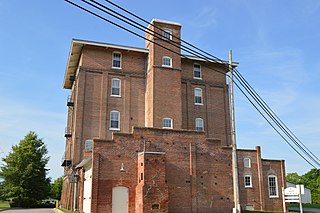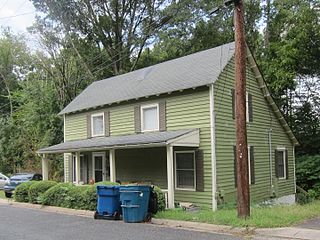
Kirks Mills Historic District is a national historic district located at Little Britain Township, Lancaster County, Pennsylvania. The district includes 12 contributing buildings in the village of Kirks Mills. They are Jacob Kirk's Mansion House, Brick Mill / Kirk's Mill, the brick miller's house, stone and log barn converted to a residence in 1975, Joseph Reynold's House (1825), Eastland Friend's Meeting and Tenant House, Ephriam B. Lynch House (1880s), Harry Reynolds House, Manuel Reynolds House, Eastland School House (1838), and Log House. The Jacob Kirk's Mansion House is a three-story, brick dwelling with a two-story ell. It features a full porch on the front and right sides. Kirk's Mill is a 2+1⁄2-story brick building with a slate gable roof. It was remodeled to a residence about 1940.

Granby Mill Village Historic District is a national historic district located at Columbia, South Carolina. The district encompasses 97 contributing buildings associated with a cotton mill and associated mill village. The mill was initially constructed in 1896–1897, and is a large four-story, rectangular brick building in the Romanesque Revival style. It features two projecting five-story entrance towers. The Granby Mill Village includes a number of "saltbox" style dwellings reminiscent of a New England mill village. The district also includes the mill gatehouse, the two-story mill office building, commercial buildings, the Gothic Revival style Whaley Street Methodist Church, and operatives' houses.

Glencoe Mill Village Historic District is a national historic district located at Glencoe, Alamance County, North Carolina. It encompasses 48 contributing buildings and 6 contributing structures built between 1880 and 1882 in Glencoe.

Franklin Pierce Tate House is a historic home located at Morganton, Burke County, North Carolina. It was designed by architect Electus D. Litchfield and completed in 1928. It is a two-story, Colonial Revival style dwelling constructed of irregularly-coursed, rock-faced granite blocks.

Dunavant Cotton Manufacturing Company, also known as Alpine Cotton Mill No. 1, is a historic cotton mill located at Morganton, Burke County, North Carolina. It is a two-story, brick-clad, side gable-roofed building. The original section was built in 1888–1910, with additions and expansions through 1966. The additions to the building, made in the mid to late 1960s were removed in 2012 to reveal the original 1888-1910 mill building. It is the oldest cotton textile mill in Morganton, and was in use as a cotton textile mill until 1949.

John Bunyan Green Farm is a historic home and farm and national historic district located near Midland, Cabarrus County, North Carolina. The district encompasses 12 contributing buildings, 2 contributing sites, and 1 contributing structure. The farmhouse was built about 1880, and is a two-story, frame dwelling with Italianate style design elements. It features a two-story gabled front porch, a gable roof, and two exterior end chimneys. Also on the property are the contributing ten outbuildings, well canopy, the Garmon Mill site, the miller's house, and the fields and woods.

Edenton Cotton Mill Historic District is a national historic district located at Edenton, Chowan County, North Carolina. The district encompasses 70 contributing buildings, 1 contributing site, 2 contributing structures, and 1 contributing object in a small mill village. It includes industrial and residential buildings developed between 1899 and 1923. Residential buildings are primarily simple one-story, single-pile, frame dwellings and some examples of the Bungalow / American Craftsman style. Notable non-residential buildings include the Italianate Revival style Edenton Cotton Mill (1899-1916), Edenton Cotton Mill Office, and First Christian Church (1916).

Double Shoals Cotton Mill is currently under renovations for use as an event venue. Other names for the mill were the Double Shoals Manufacturing Company and Lucky Stride Yarn Mill, is a historic cotton mill located at Double Shoals, Cleveland County, North Carolina, which is just north of Shelby, North Carolina. The cotton mill was built about 1874, with additions made in 1965 and in the 1970s. It is a 2 1/2-story, brick building with a shallow-pitched, side-gable-roof and Italianate style design elements. Also on the property are a contributing mill race and dam, built about 1880. The building apparently ceased all operation as a mill in the mid-1980s.

Erlanger Mill Village Historic District is a national historic district located at Lexington, Davidson County, North Carolina, USA. The district encompasses 282 contributing buildings and 7 contributing structures in a predominantly residential section of Lexington. The mill village dwellings were built between about 1916 and 1929 and include notable examples of Bungalow / American Craftsman style architecture. The dwellings were constructed by the Erlanger Mill Company as worker's housing and in a subdivision designed by noted landscape architect Earle Sumner Draper (1893–1994). The mill itself is a complex of one- and two-story mill buildings constructed from 1913 through the 1960s. Also located in the district are the Erlanger Baptist Church (1936) and Erlanger Graded School.

Leigh Farm is a historic home and plantation complex located near Chapel Hill, Durham County, North Carolina. The house was built about 1834, and is a one-story, three bay, frame dwelling with a broad gable roof. Also on the property are the contributing frame gable-roof well, dairy, smokehouse, log slave quarters, a log dwelling, corn crib, frame carriage house, and log tobacco barn.

Durham Hosiery Mill is a historic textile mill complex located at Durham, Durham County, North Carolina. It includes seven contributing brick buildings in the complex. The original Durham Hosiery Mill was built in 1902, and consists of a four-story main building with a six-story Romanesque Revival style tower in front; engine, boiler, and heater houses attached at the rear, and a one-story dye house. The main building was expanded with a two-story annex in 1904, and a three-story annex in 1906. Other buildings include the triangular Annex No. 1 (1912) and a three-story brick finishing building. By 1910, the Durham Hosiery Mills Corporation was the largest manufacturer of cotton hosiery in the world. The mill was abandoned in 1922.

Erwin Cotton Mills Company Mill No. 1 Headquarters Building, also known as Erwin Square, is a historic textile mill complex located at Durham, Durham County, North Carolina. The mill was built in 1892, and is a two-story, 748 feet long, brick building. It features three square towers projecting from the east facade and by hundreds of large and closely spaced windows. The building exemplifies "slow burn" construction with its exterior load bearing brick walls and its heavy timber heart pine beams and columns. The headquarters building is a Late Victorian style brick building built in 1892 and enlarged in 1896 and 1905. Attached to the headquarters building is a warehouse. In 1983–1984, the complex was renovated as offices and apartments.

West Durham Historic District is a national historic district located at Durham, Durham County, North Carolina. The district encompasses 101 contributing buildings in a mixed industrial, commercial, and residential section of Durham. The buildings primarily date after 1892 and include notable examples of Classical Revival, Italianate, and Queen Anne architecture. Located in the district is the separately listed Erwin Cotton Mills Company Mill No. 1 Headquarters Building. Other notable buildings include Erwin Cotton Mills Co. Mill No. 4 (1909–10), Erwin Cotton Mills Co. worker's housing (1910s), Fidelity Bank (1920s), E. K. Powe School (1928), Blacknall Memorial Presbyterian Church (1922), and St. Joseph's Episcopal Church.

Pearl Mill Village Historic District is a national historic district located at Durham, Durham County, North Carolina. The district encompasses 26 contributing residential buildings built by owners of Pearl Cotton Mills. The mill village dwellings are either two-story duplex type built about 1905 or a one-story bungalow constructed about 1924.

Hylehurst, also known as the John W. Fries House, is a historic home located at Winston-Salem, Forsyth County, North Carolina, United States. It was designed by Henry Hudson Holly and built in 1884. The house is a three-story, Queen Anne style dwelling. It features projecting gable ends with timbering and scalloped shingles and a wraparound verandah. It was built for John W. Fries, a prominent Winston-Salem industrialist, whose father built the Arista Cotton Mill Complex.
Rufus Amis House and Mill is a historic home and grist mill and national historic district located near Virgilina, Granville County, North Carolina. The house was built about 1855, and is a 1 1/2-story, "L"-shaped Gothic Revival / Greek Revival style frame dwelling. It has a roof with six gables and delicately sawn bargeboards. Also on the property are the contributing smokehouse, icehouse, privy, barn, chicken house, corn crib, mill race, former dwelling, and 3 1/2-story grist mill.

Oakdale Cotton Mill Village is a historic textile mill, mill village, and national historic district located at Jamestown, Guilford County, North Carolina, United States. The district encompasses 37 contributing buildings including the Logan Manufacturing Company complex built during the 1880s and 33 frame mill worker houses dated to the early-20th century. The factory complex consists of a three-story rectangular brick office, a one and two-story L-shaped brick factory with a four-story tower and five one-story brick warehouses, a small one-story board-and-batten blacksmith shop, and a polygonal brick smokestack.

Henry Turner House and Caldwell–Turner Mill Site is a historic home, grist mill site, and national historic district located at Statesville, Iredell County, North Carolina. The house was built about 1860, and is a two-story, three bay by two bay, frame dwelling with Greek Revival style design elements. It has a gable roof, exterior end chimneys, rear ell extension, two 12-foot-deep hand-dug cisterns, and a two-story, pedimented front entrance porch. Also on the property is the site of a grist mill, race, and dam and a family cemetery.

Tull–Worth–Holland Farm is a historic farm and national historic district located near Kinston, Lenoir County, North Carolina. It encompasses 14 contributing buildings and 1 contributing site. The district includes a significant cross section of domestic and agricultural buildings constructed between 1825 and 1942. The farmhouse was built about 1825, and is a two-story, Federal style frame dwelling. It has a gable roof, exterior end chimneys, and hall-and-parlor plan. Other contributing resources are the Cook's House, privy / chicken house, Delco house, playhouse, barn, stable, cotton gin, five tobacco barns, and a tenant house.

Piedmont Buggy Factory, also known as Bearskin Cotton Mills and Monroe Cotton Mills, is a historic building located at Monroe, Union County, North Carolina. It was built in 1910, and is a three-story, rectangular brick building with a shallow pitched gable roof. The brick is in six distinct shades of red. Also on the property are the contributing late-1910s one-story brick boiler house and a steel water tower. Originally built as a buggy factory, in the late 1910s the factory was converted to textile production and renamed the Bearskin Cotton Mills. The facility remained in operation through 1956.



















